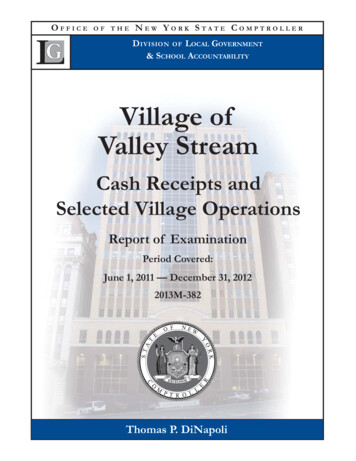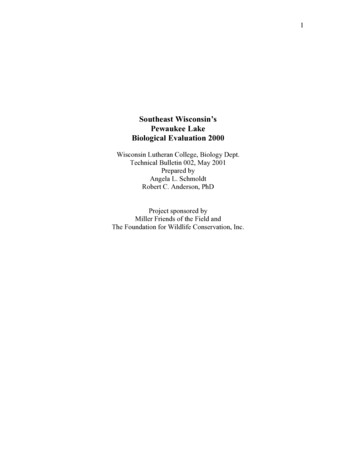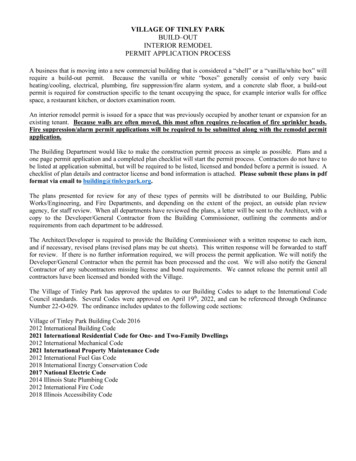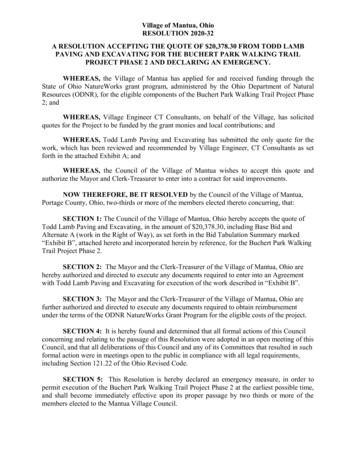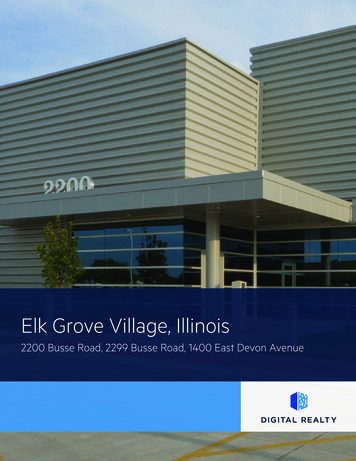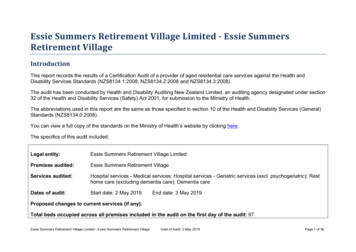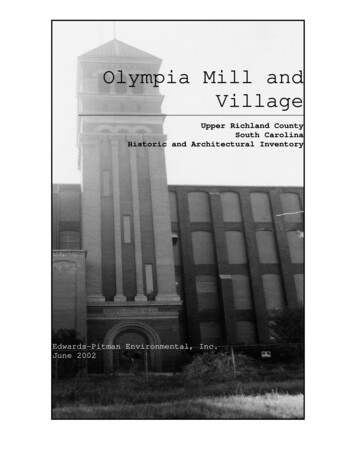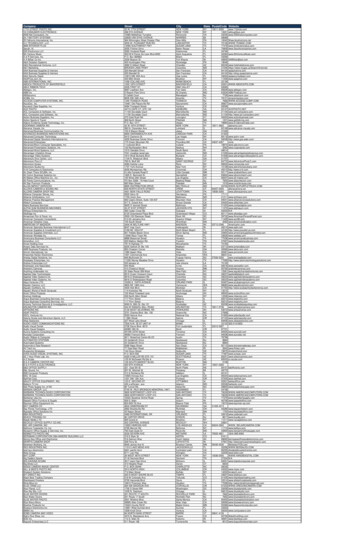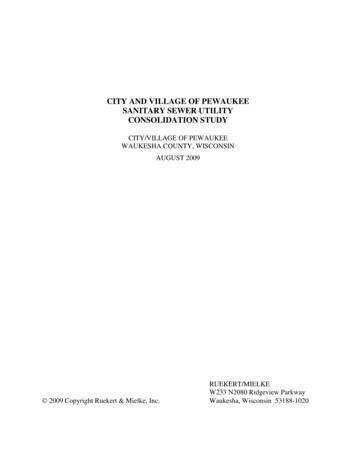
Transcription
CITY AND VILLAGE OF PEWAUKEESANITARY SEWER UTILITYCONSOLIDATION STUDYCITY/VILLAGE OF PEWAUKEEWAUKESHA COUNTY, WISCONSINAUGUST 2009 2009 Copyright Ruekert & Mielke, Inc.RUEKERT/MIELKEW233 N2080 Ridgeview ParkwayWaukesha, Wisconsin 53188-1020
TABLE OF CONTENTSEXECUTIVE SUMMARY . ES-1Introduction .ES-1Existing Studies .ES-1Existing Inter-Municipal Agreements.ES-1Service Areas .ES-2Conveyance Capacities .ES-2Treatment Capacities .ES-2Conclusion .ES-3CITY OF PEWAUKEE EXISTING SANITARY SEWERAGE SYSTEM.1Description of the Existing System.1Map 1: Existing Sewer Service Areas .2Map 2: Existing Sanitary Sewer Systems .3Existing Service Agreements .4Description of Proposed Improvements.4VILLAGE OF PEWAUKEE SANITARY SEWERAGE SYSTEM .5Description of the Existing System.5Existing Service Agreements .6Description of Proposed Improvements.6CAPITAL IMPROVEMENT PLAN REVIEW SUMMARY .6PREVIOUS STUDIES AND AGREEMENTS.7REVIEW OF TREATMENT AND CONVEYANCE CAPACITIES.9Table 1: Treatment Capacity in Million Gallons Per Day .10CONCLUSION .10APPENDIX A: SANITARY SERVICE AREA MAP EXHIBITSAPPENDIX B: 5-YEAR CAPITAL IMPROVEMENT PLANSAPPENDIX C: INTERGOVERNMENTAL AGREEMENTMENTS & STUDIESTOC-108/13/09Ruekert/Mielke SEWRPC 8009041 Pewaukee Consolidation Study 113 - Sanitary Sewer Study Reports City-Village of Pewaukee-20090813-SanitarySewer Consolidation Study.doc
CITY AND VILLAGE OF PEWAUKEESANITARY SEWER UTILITYCONSOLIDATION STUDYEXECUTIVE SUMMARYIntroductionPrior studies have shown that consolidation of the City and Village sewer utility would result inan overall benefit to each community with some reductions in administrative and maintenancecosts. Previous studies have also concluded that consolidation would have little impact on thetotal cost of the 5-year capital improvement plan from 2002 through 2006.The purpose of this report was to review the capital costs to the sanitary sewer utilities from abroader perspective that would consider future anticipated, but yet unknown, capital costs todetermine whether or not additional benefits can be achieved by a consolidation. The studyevaluated existing sanitary sewer studies, existing inter-municipal agreements between the twocommunities, existing inter-municipal agreements that each community has with other entities,existing sanitary sewer service areas, conveyance capacities and treatment capacities.Existing StudiesConclusions and recommendations found in the existing studies that were reviewed do notappear to change if the sewer utilities for the two communities were consolidated. However, abenefit to consolidation of the utilities exists because future studies would be able to openlyexplore additional service alternatives that may be more cost effective.Previous studies have assumed that the two utilities will continue to cooperate with each other byinterconnecting the two systems and allowing sewage from the City of Pewaukee to flow throughthe Village’s conveyance system. If the two utilities do not consolidate and previous cooperationbetween them is disrupted, then the City may be at risk for significant additional capital costs toprovide sewer service to portions of the City currently without sewer service. Examples ofadditional costs would include constructing a separate conveyance system to carry sewage flowsto the Village’s main sewage pump station, existing City sewage pump stations or to the FoxRiver Water Pollution Control Center (FRWPCC) in the absence of contracted reserve capacityin the Village’s sewage pump station. While some of those costs would likely be passed on fromthe City to a potential developer, the high conveyance cost may preclude further development inthat part of the City. Additionally, existing city residents may be forced to bear higher thannormal costs for inclusion in some of the conveyance facilities.Existing Inter-Municipal AgreementsExisting inter-municipal agreements between the two communities that were reviewed do notappear to have either a positive or negative impact on the current capital improvement plan costsif the sewer utilities for the two communities were consolidated with one exception. The 1991agreement between the Village and the City allows conveyance capacity for the City through theVillage at an unknown cost. However, there is a potential for an unknown reduction ofES-108/13/09Ruekert/Mielke SEWRPC 8009041 Pewaukee Consolidation Study 113 - Sanitary Sewer Study Reports City-Village of Pewaukee-20090813-SanitarySewer Consolidation Study.doc
administrative costs in the future if the utilities are consolidated and the need for independentplanning or consideration for revisions to prior agreements are eliminated. Additionally, there isa potential for future administrative cost savings when agreements with other entities impact oneconsolidated utility rather than two separate ones.To date the City has successfully negotiated cooperative agreements with the Village to providesewer service to areas in the City without sanitary sewer service that are tributary to the Village’sconveyance system. For example, an existing cooperative agreement dated January 28, 1991states that the Village will allow a connection to its conveyance system to provide sewer serviceto the northwest portion of the City. The agreement allows the Village to dictate actual costs andlocations for service. Without consolidation, the City may be at risk of significant additionalfuture capital costs as discussed above if cooperative agreements cannot be negotiated for sewerservice in the future.Service AreasIn general, the extent of future sanitary sewer service area boundaries remains unchanged in theevent that the two utilities were to consolidate. There is a potential to expand the sanitary sewerservice area to include a portion of the Town of Lisbon. The potential exists whether the utilitiesconsolidate or not. However, service to some of the areas currently without municipal sewerservice or on-site private waste disposal systems may not be feasible as discussed above.Conveyance CapacitiesBoth communities have indicated that their conveyance systems are functioning properly atcurrent levels of development and flows. Historical knowledge and review of available datashows that trunk sewer systems and sewage pump stations are functioning properly underexisting average flow conditions. During extreme wet weather conditions, minor surchargingwas reported in both communities. However, no property damages resulted from the surcharges.The Village’s main sewage pump station, which has enough capacity to handle existing sewageflow, has not been designed to its ultimate capacity to serve all potential development withineither community. Upgrades to the station will be required as additional development occurs andflows increase. The need for an upgrade of the pump station is not anticipated in the near future.An existing agreement between the two communities calls for the cost of those upgrades to beshared between the two communities and Lake Pewaukee Sanitary District (LPSD). The existingagreement limits the amount of capacity that the City of Pewaukee can utilize.Treatment CapacitiesThe treatment capacities purchased by each municipality from the FRWPCC were reviewed aspart of this report. The review showed that each community has reserve average daily flowcapacity. The Village has indicated that its remaining reserve capacity will adequately serveanticipated future development in the Village. It appears, however, that the City may not haveenough reserve average flow capacity to accommodate future potential development in the City,specifically in the northwest area.Discussions with FWRPCC confirm that average day sewage flows from each community do notexceed purchased treatment capacity. However, FWRPCC have indicated that a minorES-208/13/09Ruekert/Mielke SEWRPC 8009041 Pewaukee Consolidation Study 113 - Sanitary Sewer Study Reports City-Village of Pewaukee-20090813-SanitarySewer Consolidation Study.doc
exceedence of peak flow capacity has occurred during extreme wet weather events. The Citywill require additional average and peak flow treatment capacity for future growth.ConclusionIf consolidation does not occur and cooperation between the two communities is disrupted, thenthe utilities within the two communities would be forced to function independently and the riskfor significant additional capital costs exists to the City. Therefore, consolidation of the sanitarysewer utilities yields a lower risk of significant capital costs to the City. The following benefitscan be achieved if the two utilities consolidated:1. Reduction in inter-municipal agreement administrative costs.2. Eliminating the cost to provide new metering structures at system interconnections andrelated operations and maintenance costs.3. Increased number of sewer service alternatives to areas currently without municipalsanitary sewer service that may yield an overall lower cost.4. Lower risk to the City of significant additional capital costs to independently serviceareas currently without municipal sanitary sewer service or that are on private wastedisposal systems.5. Combined reserve treatment capacity can be utilized by development that is not confinedto one municipality or another providing greater flexibility on the timing of purchase ofadditional treatment capacity as necessary.ES-308/13/09Ruekert/Mielke SEWRPC 8009041 Pewaukee Consolidation Study 113 - Sanitary Sewer Study Reports City-Village of Pewaukee-20090813-SanitarySewer Consolidation Study.doc
CITY AND VILLAGE OF PEWAUKEESANITARY SEWER UTILITYCONSOLIDATION STUDYCITY OF PEWAUKEE EXISTING SANITARY SEWERAGE SYSTEMDescription of the Existing SystemExisting sanitary sewer service area for the City of Pewaukee is shown on Map 1. The majorityof the existing sanitary sewerage collection system is operated and maintained by the City ofPewaukee Water and Sewer Utility. The City of Pewaukee does not own and operate its ownwastewater treatment facility. The City currently contracts with the Fox River Water PollutionControl Center (FRWPCC), located in the City of Brookfield. Sewage from a portion of the Cityof Pewaukee also flows to the City of Waukesha Wastewater Treatment Facility. Wastewatertreatment and disposal for developed but unsewered portions of the City are provided by privateon-site wastewater treatment and disposal systems.The location and extent of the existing sanitary sewerage system within the City of Pewaukee isshown on Map 2. The area totals approximately 7.2 square miles or approximately 34 percent ofthe total area of the City. The system consists of approximately 69 miles of gravity flow sanitarysewers in size from 8 to 24-inch diameter, including manholes and lateral connections and 11pumping stations with approximately 1.5 miles of force mains ranging in size from 1.5 to 12inches in diameter.A portion of the City is also served by the sanitary sewer system owned and maintained by theLake Pewaukee Sanitary District. The area served totals approximately 1.5 square miles orapproximately 5 percent of the total area of the City. An intermunicipal agreement exists withthe Lake Pewaukee Sanitary District (LPSD) whereby the LPSD continues to own and operate aportion of the sanitary sewerage district within the City of Pewaukee. The City of Pewaukeereimburses the LPSD for the associated operation and maintenance costs. The system known asPump Station No. 11 service area consists of approximately 12 miles of gravity flow sewer,ranging in size from 8 to 24-inches in diameter, including manholes, building connections, liftstations and attendant force mains. The LPSD was contacted to determine if there were anyplanned capital improvement projects. At this time there are no major projects planned for theLPSD system.The City of Pewaukee sanitary sewer system presently connects into sanitary sewerage systemsowned and operated by five other entities, 1) the Village of Pewaukee, 2) the Lake PewaukeeSanitary District, 3) the Town of Brookfield, 4) the City of Brookfield, and 5) the City ofWaukesha. The City of Pewaukee sanitary sewerage system discharges into the Village ofPewaukee system at four locations, into the LPSD at one location, into the Town of Brookfieldsystem at one location, into the City of Brookfield system at three locations and into the City ofWaukesha system at five locations. For two of the locations, where the City discharges into theVillage system, an existing sewage pumping station connects to a Village force main conveyingflows directly to the FRWPCC.108/13/09Ruekert/Mielke SEWRPC 8009041 Pewaukee Consolidation Study 113 - Sanitary Sewer Study Reports City-Village of Pewaukee-20090813-SanitarySewer Consolidation Study.doc
MAP 1Existing Sewer Service AreasCity and Village of PewaukeeSewer Utility Consolidation StudyVillage of PewaukeeSanitary SewerService AreaLegendLake Pewaukee SanitarySewer Service AreaPump Station 11Service AreaCity of PewaukeeSanitary SewerService AreaCity of WaukeshaRefined Sanitary SewerService AreaI:\Projects\8009\041\Map1-Sanitary Service Areas-NoPS.mxd202,5005,000FeetDate: July 31, 200910,000
MAP 2Existing Sanitary Sewer SystemsCity and Village of PewaukeeSewer Utility Consolidation StudyLegendVillage of PewaukeeSanitary SewerSystemLake Pewaukee SanitarySewer SystemPump Station 11Service AreaI:\Projects\8009\041\Map2-Sanitary Service Areas.mxdCity of PewaukeeSanitary SewerSystemCity of PewaukeeArea Served by theCity of Waukesha302,5005,000FeetDate: July 31, 200910,000
Existing Service AgreementsThe City of Pewaukee has existing service agreements with the LPSD, the Town of Brookfield,the City of Brookfield, the City of Waukesha and the Village of Pewaukee for the conveyance offlows into each of those systems. Additionally, for each of the respective areas where sewageflows from the City of Pewaukee into another municipal entity, there is an intermunicipalagreement entered into between the City of Pewaukee and the respective governing body.Appendix C lists those agreements that have been made available for review in conjunction withthis report.Description of Proposed ImprovementsThe City of Pewaukee has undertaken the majority of the planned improvements to its systemover the past five years. The City of Pewaukee has completed or is currently working on someimprovements for the sanitary sewers in the area bounded by Hwy “16” on the west, Fox Riveron the east, and I-94 on the south. There are no plans for further capital improvements for theexpansion of sanitary sewers within this area. These improvements have occurred since the 2001consolidation study between the City and the Village of Pewaukee was drafted. The exception tothis would be the capital improvement project for the Sherwood Forest area. The improvementsfor the Sherwood Forest area lift station were estimated in 2001 at approximately one milliondollars. However, at this time, the City of Pewaukee has no immediate plans for the constructionof the Sherwood Forest lift station. If the Sherwood Forest lift station were to be constructed it isassumed to be tributary to the City of Waukesha sewerage system after the year 2014, unlesssponsored by a separate subdivision development agreement.The City of Pewaukee has indentified three projects in their 5-Year Capital Improvement Plan.These projects include the rehabilitation of the Northmound Lift Station in 2010 and therehabilitation of the Jericho Lift Station in 2011. The rehabilitation of these stations are formaintenance as they approach the end of their equipment lifecycles. The third project includes acontinuing maintenance program to identify and reduce points of clear water inflow andinfiltration in their collection system. These costs are shown on Table B-2 in Appendix B.We have also reviewed the FRWPCC Capital Improvement Plan. This is shown on Table B-3 inAppendix B. The FRWPCC allocates these costs to the contributing communities on the basisof their percentage of combined capacity allocation. The City of Pewaukee’s combined capacityallocation is 17.48 percent. On this basis, the FRWPCC allocations would be approximately 472,000.00 in 2010 for the bar screen upgrade and 524,000.00 in 2011 for the membrane filterupgrade.Other potential future improvements for the City of Pewaukee sewerage collection system wouldinclude the extension of sanitary sewers to existing areas in the northeast quadrant area and to thenorthwest quadrant area. The Springdale Road Interceptor was sized to include the northeastquadrant area. In the northeast quadrant area, an area that is most likely subject to the largestamount of development, the City of Pewaukee has adopted a stance of not extending the sanitarysewers in these areas until such time as development has paid for the cost of those sanitarysewers. For this reason, the City of Pewaukee has not planned for any capital improvementprojects in the northeast quadrant area through the year 2014.408/13/09Ruekert/Mielke SEWRPC 8009041 Pewaukee Consolidation Study 113 - Sanitary Sewer Study Reports City-Village of Pewaukee-20090813-SanitarySewer Consolidation Study.doc
This would leave the remaining proposed improvements that may occur in the northwestquadrant of the City of Pewaukee. The northwest quadrant is generally located north of STH“16” and west of the Village of Pewaukee. This area was not included in the sewer service areaas defined in the Planned Sanitary Sewer Service Areas in the Region by SEWRPC prior to2008. However, a portion of this service area is shown to be included as of December 2008.The area contains approximately 814 gross acres. Approximately 287 acres are undevelopable orproposed county park lands. The remaining developable area includes approximately 327 acresof residential, 132 acres of manufacturing and 56 acres of commercial and mixed office land inthe area. Not including the county park, there is approximately 12 acres of institutional use inthe northeast corner of the area.The estimated sanitary sewer flows for the northwest area are based on several assumptions. Theservice area is assumed to develop to 80% of the gross acreage within each land use category.The developable acreage is referred to as the net acreage. The remaining 20% of the service areais assumed to be roads or green space and will not contribute to the future sanitary sewerageflow.For developable residential and agricultural lands, it is assumed that the future zoning will allowan average density of 2 lots per acre with an average occupancy of 3 people per residentialdwelling. Residential flow calculations are based on 125 gallons per capita per day times afactor of 5 for peak flow. For industrial and small business land use, peak usage was assumed tobe 0.0155 cubic feet per second (cfs) per acre and 0.0125 cfs per acre, respectfully. Theseassumptions are considered conservative, but are in general conformance with the City ofPewaukee Land Use Plan.Based on the above, the estimated future peak sanitary sewer flow from this area is 5.03 cfs. It isanticipated that the majority of this flow will not be contributing to the system until after 2014.The future Northwest Area Sewer Study, which is currently on hold, will identify where and howthese flows would be connected to the existing system.The Village-wide sewer system study, which is also on hold will need to be completed todetermine if there are any capacity improvements needed to service this area.As with the northeast quadrant area, the City has not planned for any capital improvementprojects until such time as development has paid for planning, design, and construction of theseimprovements. The City has a cooperative agreement with the Village to allow it to connect tothe Village’s conveyance system to provide sewer service to this area. The 1991 agreementallows conveyance capacity for the City through the Village at an unknown cost.VILLAGE OF PEWAUKEE SANITARY SEWERAGE SYSTEMDescription of the Existing SystemExisting sanitary sewer service area for the Village of Pewaukee is shown on Map 1. Theexisting sanitary sewer system within the Village is wholly owned and operated by the Village ofPewaukee Water and Sewer Utility. Wastewater treatment and disposal for the developed butunsewered portions of the Village is provided by on-site wastewater treatment and disposalsystems.508/13/09Ruekert/Mielke SEWRPC 8009041 Pewaukee Consolidation Study 113 - Sanitary Sewer Study Reports City-Village of Pewaukee-20090813-SanitarySewer Consolidation Study.doc
The location and extent of the existing sanitary sewerage system within the Village of Pewaukeeis shown on Map 2. The area totals approximately 3.2 square miles or approximately 70 percentof the total area of the Village. The system consists of approximately 34 miles of gravity flowsanitary sewer, ranging in size from 8 to 48 inches in diameter, and related appurtenant facilities,such as manhole and lateral service connections and 6 pumping stations, includingapproximately 8 miles of attendant force mains. The Village of Pewaukee does not own andoperate its own wastewater treatment facility. Wastewater from the Village is conveyed to,treated and disposed of at the FRWPCC. The Village sanitary sewer system is tributary to theFRWPCC via Pump Station No. 1 and a dual force main that conveys flows directly to theFRWPCC.Existing Service AgreementsThere are multiple existing agreements between the Village of Pewaukee, the City of Pewaukee,and the Lake Pewaukee Sanitary District. These agreements limit conveyance capacity and shareoperation and maintenance costs, administration, and construction costs of the existinginterceptors, sewers, Pump Station No. 1 and the force mains. Appendix C lists thoseagreements that were available for review in conjunction with this study.Description of Proposed ImprovementsThe Village of Pewaukee 5-Year Capital Improvement Plan is shown on Table B-1 inAppendix B. The Village plan has the FRWPCC improvements in a different sequence thanshown by the FRWPCC on Table B-3 in Appendix B. Regardless of the date shown, theinclusion of the improvements does not impact the consolidation of the two municipalities.Anticipated projects in the Village are limited to on-going system maintenance. No significantprojects are planned that would have an impact on a consolidation of the two systems.CAPITAL IMPROVEMENT PLAN REVIEW SUMMARYCurrently, both the City of Pewaukee and the Village of Pewaukee have a limited number ofcapital improvement projects planned. The need for those projects is not impacted by a utilityconsolidation. Therefore, the cost savings from the consolidation of the two systems wouldcome from operating efficiencies created by combining the systems. As an example, if thenorthwest quadrant area were to be developed under a consolidated utility, the construction of ametering facility may not be needed. While this has an approximate cost savings of between 50,000 and 80,000 for the facility itself, there are additional on-going costs that would beeliminated.These would include the electrical costs and on-going maintenance andadministrative costs for such a facility. The cost incurred by either municipality to negotiate anintermunicipal agreement for such a system would also be avoided. In the event that there mayneed to be improvements to the main Village Pump Station No. 1 or the dual 20-inch and 30-inchforce mains that are tributary to the FRWPCC, the need to negotiate and assess costs would notexist.The FRWPCC 5-year Capital Improvement Plan is shown on Table B-3 in Appendix B. Theplan includes four projects. There are two additional projects that are found on the WisconsinClean Water Fund Program American Recovery and Reinvestment Act Funding List that are notshown in Table B-3. These two projects are not listed in the Capital Improvement Plan for theCity and only one appears to be listed in the Capital Improvement Plan for the Village. They are608/13/09Ruekert/Mielke SEWRPC 8009041 Pewaukee Consolidation Study 113 - Sanitary Sewer Study Reports City-Village of Pewaukee-20090813-SanitarySewer Consolidation Study.doc
the Bio-Solids Thickening project and the Addition of 2 Deep Bed Filters project. The list showsthe estimated cost of the two projects totaling 3,600,000 with half of the estimated project costbeing funded by a grant through the American Recovery and Reinvestment Act (ARRA) and theother half being funded through the Clean Water Fund Loan Program. These six projects for theFRWPCC have a cost share impact on both the City and Village. The cost share does not appearto change whether the two utilities are consolidated or not.Future capital improvements that would benefit both existing utilities would have loweradministrative costs since there would no longer be the need to analyze the net benefits to eachutility for the division of fiscal responsibility. The need for duplicate review of the analyses andthe need for meetings to negotiate the cost allocations would not exist. It is difficult to ascertainwhat these total costs are because those costs vary in the actual monetary costs for eithermunicipality to hire either consultants, such as engineers or legal staff, and the amount of stafftime needed to administer the negotiations from both the public works directors or theadministrative staff of both municipalities. By consolidating the two utilities, time spent onnegotiating agreements would then be time that could be reallocated to the long-term operationand maintenance of the infrastructure at hand.Additional cost savings may occur if the agreements for the Village Pump Station No. 1 nolonger existed, then the administrative costs that are shared semi-annually between the twocommunities for the administration of a Clean Water Fund Loan would be reduced.More importantly, if the two utilities do not consolidate and previous cooperation between themis disrupted, then the City may be at risk for significant additional capital costs to construct aconveyance system separate from the Village’s to serve new areas. The separate system mayneed to carry sewage flows to the Village’s main sewage pump station, to existing City sewagepump stations or to the Fox River Water Pollution Control Center (FRWPCC) if contractedreserve capacity in the Village’s sewage pump station is exceeded. Therefore, under thisscenario the City would benefit from a consolidation of the utilities by a reduction in the risk forsignificant additional capital costs.PREVIOUS STUDIES AND AGREEMENTSWe have completed a review of documents relating to the Intergovernmental Agreementdocuments between the two municipalities, as well as between each municipality and othergoverning bodies. A list of those agreements that were available for review in conjunction withthis study are listed in Table C-1 in Appendix C.To date the City has successfully negotiated cooperative agreements with the Village to providesewer service to areas in the City without sanitary sewer service that are tributary to the Village’sconveyance system. The majority of existing inter-municipal agreements between the twocommunities that were reviewed do not appear to have either a positive or negative impact on thecurrent capital improvement plan costs if the sewer utilities for the two communities wereconsolidated. However, an existing cooperative agreement dated January 28, 1991 between theVillage and the City allows conveyance capacity for the City’s northwest area through theVillage at an unknown cost. Without consolidation, the City may be at risk of significantadditional future capital costs as discussed previously if cooperative agreements cannot benegotiated for sewer service in the future.708/13/09Ruekert/Mielke SEWRPC 8009041 Pewaukee Consolidation Study 113 - Sanitary Sewer Study Reports City-Village of Pewaukee-20090813-SanitarySewer Consolidation Study.doc
There is a potential for an unknown reduction of administrative costs in the future if t
The City of Pewaukee sanitary sewer system presently connects into sanitary sewerage systems owned and operated by five other entities, 1) the Village of Pewaukee, 2) the Lake Pewaukee Sanitary District, 3) the Town of Brookfield, 4) the City of Brookfield, and 5) the City of Waukesha.
